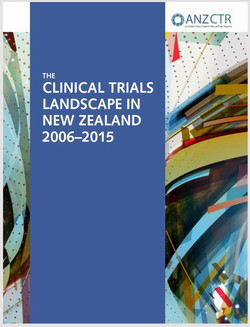A new report by the Australian New Zealand Clinical Trials Registry (ANZCTR) provides a comprehensive profile of clinical trials in New Zealand registered between 2006-2015.
The report ranks New Zealand within the top tier internationally of trials per capita, with about 2,500 clinical trials conducted during the decade.
These trials ranged from single-site New Zealand-only trials through to multinational mega-trials. A total of 1.6 million participants were enrolled, taking into account the New Zealand and overseas arms of the trials. More than 50% of trials in NZ were multinational, and Industry was involved in 55% of registered clinical trials. The most frequently studied health issues were cancer, cardiovascular disease and respiratory diseases.
The Health Research Council of New Zealand (HRC) supports registration of all New Zealand health research and has been the key contact for the ANZCTR since its establishment in 2005. The HRC alone has contributed more than $94 million to clinical trials in New Zealand within the timeframe captured in the report.
“Clinical trials are a pillar of an effective and efficient health system, and this report provides unprecedented detail on the landscape of clinical trials in New Zealand,” says Professor Kath McPherson, chief executive of the Health Research Council of New Zealand.
“The data show that clinical trial activity in New Zealand is high by international standards and has risen significantly over the decade, providing vital evidence for health sector decision-makers, opportunities for health professionals to engage in research, and enabling New Zealanders to access the best available healthcare options.”
She adds that the high rate of international collaboration, as reflected in this report, brings benefits to New Zealand by providing access to larger participant numbers and more conclusive answers to important questions. It also means patients can access treatments that aren’t yet in usage in New Zealand. “This report demonstrates that the value of the ANZCTR exceeds its core purpose to enable fulfilment of ethical requirements. The Registry also provides data to identify national trends, strengths and opportunities to inform the future health research agenda,” says Prof McPherson.
“We welcome the high-quality data collection that’s enabled this report and encourage New Zealand researchers to continue to register their trials and update their data throughout the lifecycle of the trial.”
The report draws upon data collected through the ANZCTR and ClinicalTrials.gov, which combined are estimated to capture 82% of registered trials with New Zealand sites.
Key findings of the report:
· During the decade 2006-2015, clinical trial activity in New Zealand has been substantial, with 2,485 clinical trials conducted with one or more New Zealand sites. More than 1.6 million participants were enrolled, taking into account the New Zealand and overseas arms of the trials.
· On a per capita basis this level of activity compares favourably with other countries internationally, with New Zealand being in the top tier of national clinical trial activity; above Australia, Norway, Ireland, Canada, and the UK, for example, and below Denmark.
· A large proportion of New Zealand clinical trials are multinational (51% compared to 33% for Australian trials), demonstrating a high degree of international connectedness and collaboration. Australia is the top collaborator with New Zealand, but other countries that New Zealand trialists have a high level of collaboration with include the United States, Canada, Germany and the United Kingdom.
· A greater proportion of New Zealand trials have industry involvement compared to Australian trials (55% versus 45% respectively). A range of non-commercial funders in New Zealand also support clinical trials.
· Clinical trials in New Zealand assess multiple types of interventions, including drug treatments (52%), surgery (4%), medical devices (13%), behavioural therapies (6%) and prevention strategies (9%). The range of activities includes large multicentre phase 3 trials that are likely to impact clinical practice directly, as well as early-phase trials testing novel therapies or interventions that may become the new best treatments of tomorrow.
· There has been proportionally more activity in the areas of greatest national disease burden, with the most common disease areas studied in New Zealand clinical trials being cancer, cardiovascular disease and respiratory diseases, representing 15%, 13% and 11% of all trials, respectively. However, some areas of high disease burden such as musculoskeletal disorders, mental disorders, and injuries remain under-represented.
· The decade has seen several interesting national trends in registration of clinical trial activity:
- Moderate growth in the total number of trials registered each year, mainly reflecting increases in smaller-scale trials and non-drug interventions.
- Increase in the number of New Zealand trials registered prospectively (i.e. before enrolment of the first participant) with this sitting at around 75% at the end of the decade.
- A marked increase in phase 1 trials as a proportion of clinical drug trials registered over the decade, from 6% in 2006 to 30% in 2015.
- The absolute number of New Zealand registered trials sponsored by the commercial sector has increased over time.
- Reduction in trial size over the decade – from a median of 230 participants per trial down to 80. This may reflect appropriate changes in design for more targeted therapies or, conversely, inappropriate reductions in sample size resulting in trials that are underpowered to detect significant, but moderate, treatment benefits. This is an area which warrants further in-depth assessment.
· Along with this good news, the report highlights that New Zealand has huge potential to grow capability and capacity for clinician-led trials in the non-commercial sector, for example comparative effectiveness research, non-drug interventions (such as behavioural therapy), and interventions for more effective prevention and diagnosis. We also need to increase our understanding of which clinical trials have resulted in translation of evidence for the benefit of patients and/or the broader community.
